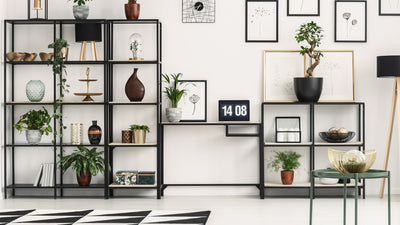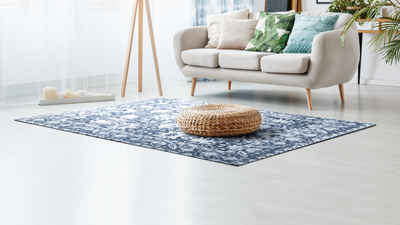How To Implement Contemporary Interior Design In Your Home
It can be hard to define what we mean by ‘contemporary’ design. According to the dictionary, something is contemporary if it has occurred recently or is occurring in the present. To that point, most designers will say contemporary design is a fluid, ambiguous concept that is always adapting. However, there are certain aspects that allow us to identify contemporary style when we see it - at least, for now.
If you love having your finger on the pulse of trending interior design, then you’ll love the contemporary aesthetic. This style reflects all the most pivotal moments of the last few decades, and its ever-changing definitions have one thing in common - it is a flexible fashion in flux, meaning you can change it to suit your needs not just in the now, but in the future.
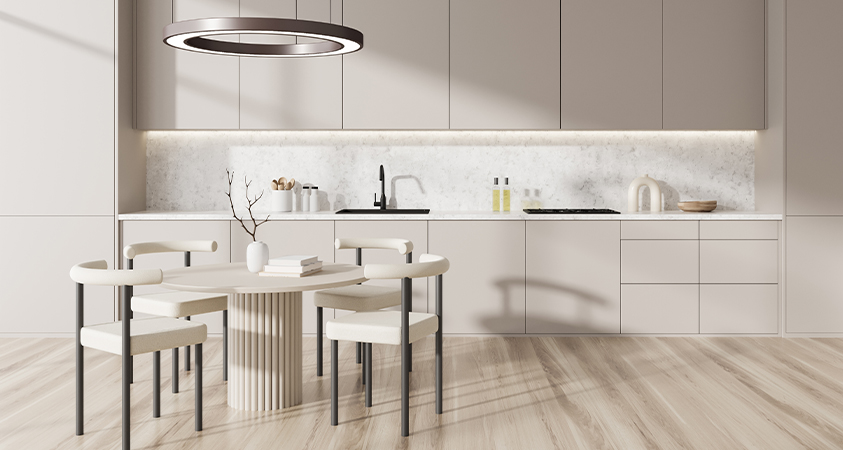
As one of the leading online furniture brands, Artiss is no stranger to contemporary interior design styles. Come with us to explore this fascinating era of modern interior design and be inspired by our contemporary interior design ideas.
What is Contemporary Styling in Interior Design?
Contemporary style is unique because it borrows from several other styles and trends to create a versatile, chameleon-esque aesthetic that suits most homes. You can find aspects of modern, post-modern, art deco, traditional, minimalist, and even futuristic trends weaved through a contemporary home, and yet it still has its own distinct flavour.
Key elements of a contemporary design style home in 2023 may have a neutral colour palette with the occasional bold black, white, or other accent shade. The furnishings will have a variety of mixed textures, organic silhouettes and a streamlined design, arranged in an open floor plan. It may use a variety of natural, sustainable materials. There will be a balance of practical task lighting and access to natural light through untreated, uncovered windows. Though the home may not feel particularly ornate, each piece in a contemporary home has been specially curated for an effortless yet unique style.
What is the Difference Between Modern and Contemporary Interior Design?
While the words modern and contemporary both refer to the present day, they are distinctly different interior styles.
Modern interior design style refers to a specific time period. It grew out of the modern design movement, which began in the early 1900s and declined around the early 1950s. You can trace its roots to Bauhaus and Scandinavian design. Modern interior design embraces the “form follows function” philosophy, meaning an object’s aesthetic should reflect its purpose. It features strong, clean lines, natural materials, and functional furnishings with minimal flourish. It is a style with strict rules.
Contemporary design does not refer to a specific time period, as it is always in flux, though some say contemporary interior design as we know it became popular around the 1970s. It takes the best from pivotal interior design styles and adapts them to current trends for modern homes. While contemporary design currently trends toward minimalism, it may look very different in the next decade.
Both styles favour simplicity, clean straight lines, and neutral colour palettes.
How to Design a Contemporary Interior?
Where many modern-style homes can seem cold and bare, a contemporary home has a more relaxed feel while remaining uncluttered, subtly minimalist, and effortlessly sophisticated. Think of it like this: rather than showcasing a collection (or lack thereof), contemporary design aims to showcase a space.
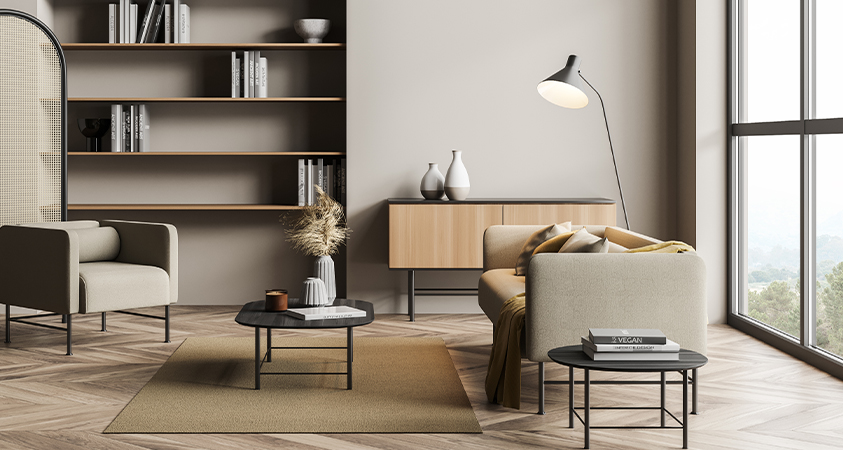
There are some key features you’ll want to include to create a cohesive contemporary feel to your interior design.
-
A neutral colour palette with the occasional bold colour accent will make the room feel warm and homey. Don’t forget, while pure neutral colours are white, black, brown, and grey, you can mix these with other primary colours to make warm and cool tones in a variety of hues.
-
Prioritise natural and sustainable materials and finishes. This might take the form of an exposed brick wall or wood beams, natural fibre carpeting against hardwood floors, stone benches and clear glass. Metal may also feature prominently, whether in an industrial-style application, as a metallic accent or as a textural element.
-
Where you can’t get natural sunlight, make liberal use of accent and task lighting.
-
Mix textures for a creative, welcoming space. This can be accomplished by incorporating different materials, patterns or shapes.
-
Architectural elements like exposed brick walls, creative moulding or exposed wood beams can also add character to an otherwise empty room.
-
Contemporary homes love open spaces, and you'll find many open floor plans by interior designers to create a wide open, multi-use space.
Read on if you’re interested in hearing more about these key characteristics in-depth.
Key Characteristics of Contemporary Style Interior Design
Colour
Neutral colour palettes are a key feature of a contemporary style home. Pure neutral colours are black, brown, white and grey, while warm and cool neutrals occur when mixing a pure neutral with a primary colour. Neutrals are great for contemporary homes because they are infinitely flexible. They pair well with most other colours and interior styles so you can mix, match and update your decorating style at any time. They will suit any season and have a naturally calming effect that will help you feel relaxed and unbothered. Pair neutral colours with your favourite bold colour and you’ll create a natural focal point that will draw the eyes of your guests to your favourite reading nook, entertainment space, or dining area. You can go with high contrast or subtle sophistication, whatever best reflects your love of colour.
Textile Fabrics & Materials
There is a focus on sustainability and the use of natural, organic materials in contemporary design, but there is also plenty of interest in innovative materials. Some contemporary rooms might lean towards a Scandinavian, Hamptons or rustic look with plenty of wood furniture, woven rugs and linen upholstery, while others may take cues from the industrial or Art Deco era with plenty of metallic frames and accents set against dark neutral tones.
Contemporary fabrics include linen, cotton, silk and wool. Patterned fabrics are on the subtle side, though you may also find bold geometric patterns, bright colour accents, and trending retro-style designs. Avoid chaotic, over-the top fussy prints that might overwhelm your decor.
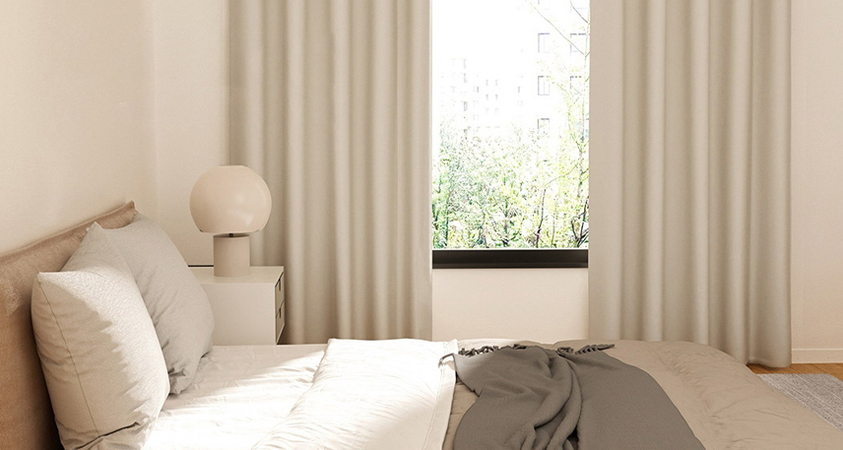
Use of Lighting
Lighting is an essential element when it comes to decorating. Natural lighting is the best way to highlight your pieces and has antibacterial properties that will benefit your home. Use large windows in your living space, dining room and bedroom. Where you can’t get natural light, you can use light fixtures such as track lighting, recessed downlights, LED strips or any lights that have minimal ornamentation and innovative shapes, styles or materials. If you're concerned about window glare, you can use contemporary window treatments like blackout curtains, shutters or roller shades.
Furniture Choices
Contemporary furnishings straddle the line between loud and minimalist. They feature simplistic, comfortable designs in clean geometric shapes. There’s little to no excess decoration - no fringes, studs, tassels, baubles or loud patterns. Upholstery is usually made from natural materials like cotton, silk, linen, wool, rattan or jute.
Incorporating Pattern
Clean lines and shapes are all well and good, but a room that’s too sleek can feel soulless. Incorporating patterns into the room is an easy way to create a distinct look that brings character, texture and interest to your space. Contemporary patterns are best when they are simple and concise. Geometric prints, stripes, marble and simple patterns based on nature with a neutral, two-tone or monochromatic colour palette are good choices, or you might look for pieces inspired by contemporary artists for that extra flair.
Examples of Contemporary Interior Design
Contemporary Living Room
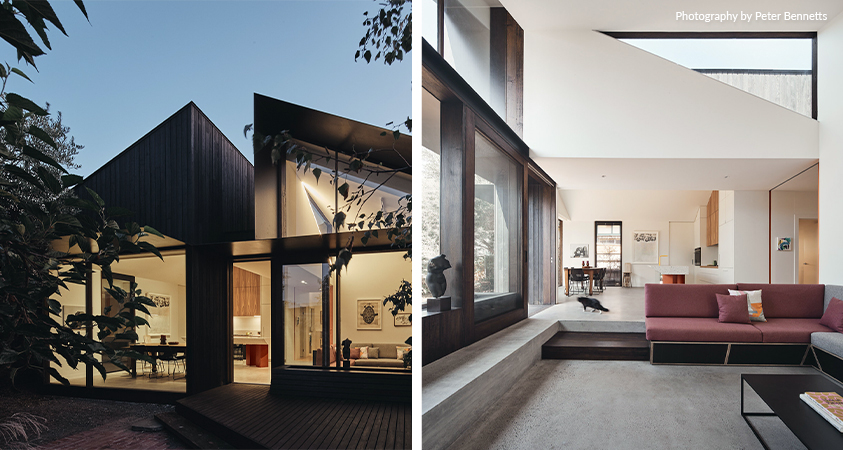
The perfect contemporary living room has comfortable and cosy furniture, ample lighting from inside and out, and plenty of personal touches in the form of colour, artwork and decor. The gorgeous Split House designed by FMD Architects has all the hallmarks of incredible contemporary design. The neutral colours of the white walls, stone floors and decorative wooden accents are offset by bright orange, purple and yellow pops of colour. The room is lit by a mixture of recessed lights, a skylight and the large bay windows set in a dark wood frame. It is also open plan, connected to the kitchen, dining, and outdoor sitting area. Architectural details are used to create distinct spaces, such as the ‘split’ in the roof which is reflected internally through the ceiling, splitting the open room into a recessed lounge area and a dining and kitchen area.
Here are some ways to replicate a contemporary look in your own living room.
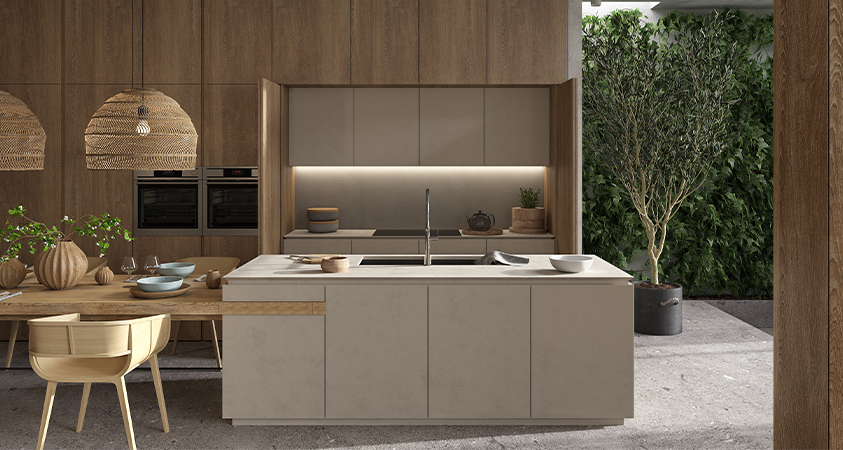
Open plan
Open spaces have many benefits. They are perfect for entertaining, keeping an eye on the family, brightening up your space, and promoting proper air circulation. You can be more flexible with your furniture choices and configurations. There is plenty of room to move around and go about your day. If you worry your space will look too big and sparse, you can create dedicated zones to differentiate your daily activities using rugs, differently coloured or textured furnishings, or unique architectural qualities.
Natural light
Everything looks better under natural light, and it makes you feel better too! Not only does sunlight bring the perfect lighting conditions for most tasks, but it also helps to deodorise a room, keep you warm even in winter, raise your serotonin levels (to improve your mood) and keep your body clocks in sync.
Contemporary homes tend to be bright, open and welcoming, and there’s nothing more welcoming than a sunkissed living space.
Lots of greenery
Natural elements like plants are one of the easiest ways to add colour and life to your decor. They fit nicely with sustainability trends and can be as subtle or as outlandish as you like. Succulents and cacti suit a contemporary space nicely thanks to their clean shapes, and for the black thumbs in the house they’re hardy and easy to care for. A glass terrarium makes for an ideal contemporary decor piece, as glass is not only stylish but looks less heavy than traditional planters and lets the plant receive plenty of light.
Contemporary Dining Room
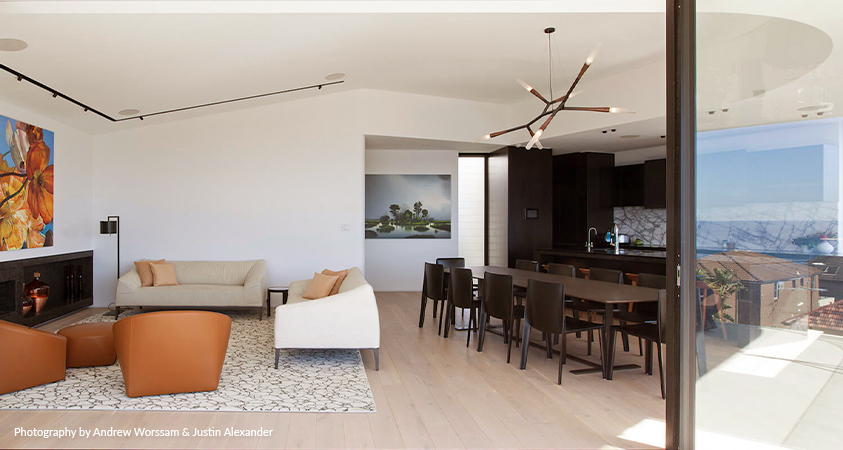
Overlooking Tamarama Beach in Sydney, the Tamarama house has a beautiful open plan living/dining space that shows the best of what contemporary style has to offer. The contemporary style kitchen uses dark colours for dramatic effect, and you’ll see multiple different textures - the marble splashback, stone bench, wood floorboards and wood stools all work together to create a bold, interesting kitchen space. Recessed lights are placed in key preparation areas for sufficient task lighting, and plenty of windows allow for natural light. The dining table and chairs are black and deep, rich brown, placed under a sharp branch-like pendant light. The colours of this space contrast the living room, which is full of creams, light browns, and other warm neutral tones.
Your contemporary dining room might benefit from the following features.
Functional light fixtures
Sight is more important than you think when it comes to food. If your food looks washed out, it’s going to taste washed out too…assuming you can see it! That’s just one of the reasons why having the right light in your kitchen and dining room is important.
You can’t always rely on natural light when cooking dinner, so artificial light is the next best thing. Recessed or pendant lights right above the dining table and preparation area will give you plenty of light to cook, eat and entertain by. You’ll want to choose warm white lighting for the perfect atmosphere.
Make your walls interesting
Your entertaining space should feel alive, dynamic and interesting. Impress your friends and family by making sure there’s always something to look at. You don’t have to completely clog your walls with art, but a statement piece here or there could make or break your dinner conversation.
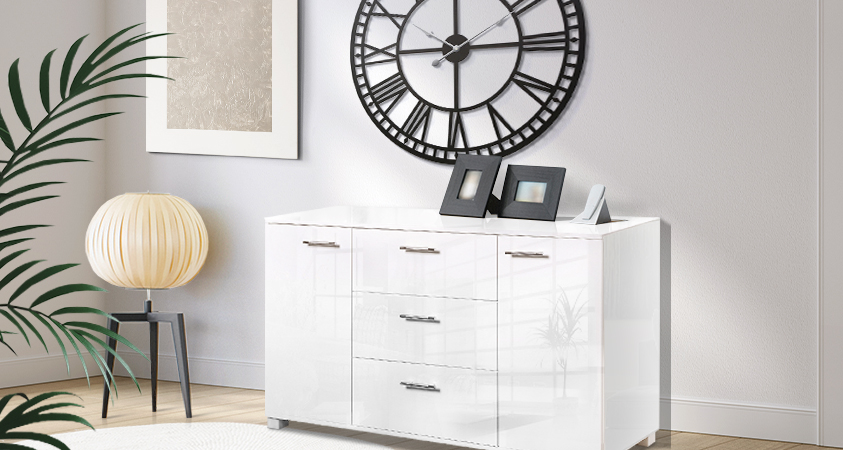
If you want your dining room to look bigger, hang a mirror over a matching sideboard or console table. For an interesting talking point, you could hang one large painting or create a small gallery of wall art. If you haven’t found any art that you love, you could choose something functional like this stylish wall clock.
The right chairs
The perfect dining chairs strike a balance between comfort and style. The easiest way to do this is to buy a table and chair set, but we aren’t always so lucky! When looking for a matching dining set, try to match the chairs to the table. You can do this by choosing similar or complementary colours or contrasting textures, such as pairing a metal table with velvet seats. Make sure you consider the right chair height and width for your table, or you might find yourself knocking knees with your guests. For more information on choosing the right dining set, read our blog How To Choose The Right Dining Table Set for Your Home.
You don’t have to choose between comfort and decor - with Artiss dining chairs you can have both. The soft velvet, smooth curves and neutral hues of the Adamas Dining Chair will fit right into your contemporary dining room. Made with a comfortable wide seat, sturdy fixings and solid iron legs, the chair will stay comfortable through an entire dinner party and beyond.
For something a little sharper, the Lylette Dining Chair is a gorgeous addition to the table. It has a plush PU leather cushion, comfortable back support and strong steel legs. Their versatile design will suit any room of the home, so you can use them whenever you need them.
Contemporary Bedroom
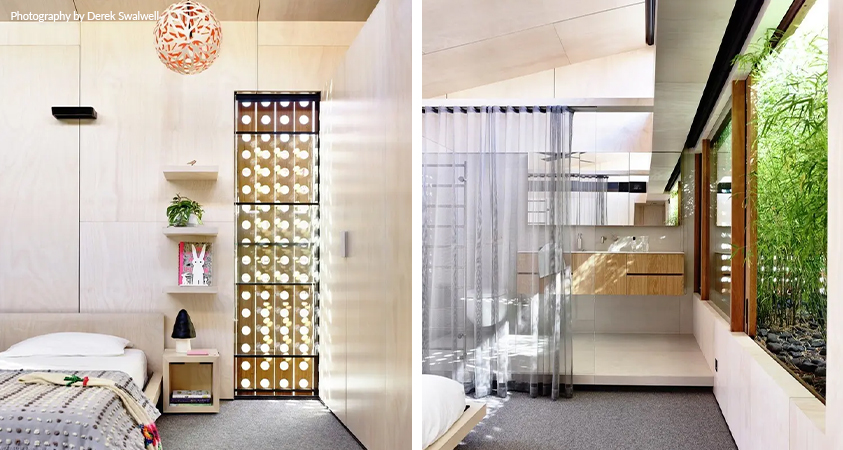
Many modern styles are criticised for being cold, lifeless or intimidating, but the bedroom is where these styles can really shine. You can be comfortable while also being contemporary, as shown in these gorgeous bedrooms from the Beach Av house designed by Schulberg Demkiw Architects. This bedroom features plenty of warm hues that pair perfectly with the pale wood and stone walls. The bed frames have a minimalist design with a headboard that blends perfectly into the surroundings. In the left bedroom you can see a set of shelves with warm Hollywood glamour-style lights and a creative plant-like pendant lamp with an orange interior for a pop of colour. A textured throw blanket is used on the bed for comfort and visual interest. The bedroom on the right uses an open plan that even extends to the bathroom, with an elegant grey curtain and glass wall to separate the spaces. A large sliding window opens right onto a bright green garden. The plants provide colour, life, and some natural sun blockage to prevent glare.
With the right care and attention, your contemporary bedroom can be just as cosy and comfortable during long nights.
Bold throw pillows and blankets
A carefully placed throw pillow can elevate your bedroom in terms of decor and comfort. If your room feels a little lacklustre, you can quickly throw on a textured or patterned throw blanket to draw the eye and also stay warm. On top of the blanket, add some throw pillows. These could feature bold-coloured patterns, contemporary artwork, commemorative photos, or different shapes. Your bed will look incredibly warm and inviting, and your bed will be the decorative star of the bedroom.
Wood accent pieces
Wood is a naturally pleasing aesthetic. It is simple, sustainable, and can help you feel closer to nature. Woods like oak, cherry and mahogany are made of warm tones like yellow, orange and red, making rooms seem warmer, cosier and more active. Ash, pine and maple woods have cool tones, which are calming and great for bedrooms.
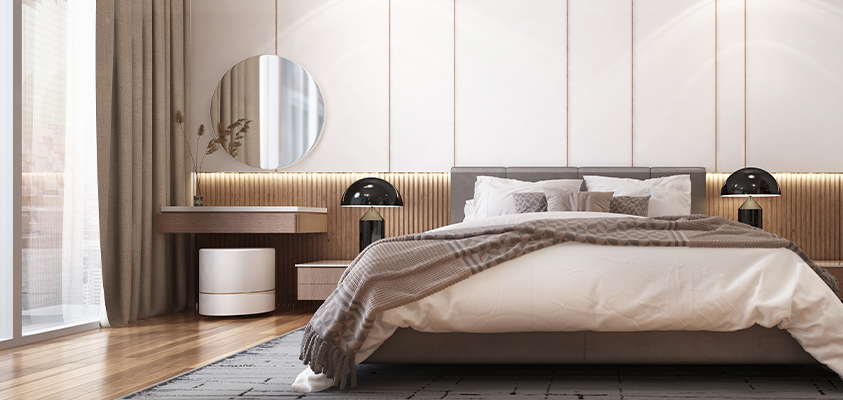
Next-level accent wall
Your accent wall doesn’t have to just be a single colour. For something more dynamic and exciting, try a contemporary-style patterned wallpaper. For something even bolder, a textured wall adds a whole other dimension to the room. This could be an exposed brick or concrete wall, decorative slats, or a living wall of plants (plastic or otherwise…we won’t tell).
What will contemporary interiors look like in the future?
While it’s impossible to predict the future, there are certain trends that we can use to predict the future of contemporary design.
The future is sustainable
Sustainability has never been such a hot topic with consumers. Big brands are committing to combat climate change, whether through recycled materials and products, sustainable packaging, more ethical production lines or other carbon offsetting measures. Furniture and decor of the future may be made from sustainable materials such as biodegradable fibreboard, bioplastics, plant-based leather, and 100% recycled plastics.
AI designs
While AI won’t be designing your home any time soon, it has certainly made the process easier for the average homeowner. Tools like REimagine can show you what your home looks like in different interior or exterior styles. Some tools can be used to draw mock-ups of spaces. We might even see AI-generated art adorning walls. The possibilities are as endless as the potential.
The nostalgia factor
This trend is being driven by Millenials and Gen Z, who are feeling especially nostalgic for 90s and 80s fashion and media. These demographics are buying anything that evokes their favourite era, from flared jeans to Disney remakes. We might see nostalgia affect contemporary art through typography, retro patterns, vintage replicas and darker, more saturated colour palettes.
These are just some insights into the possible future of contemporary design.
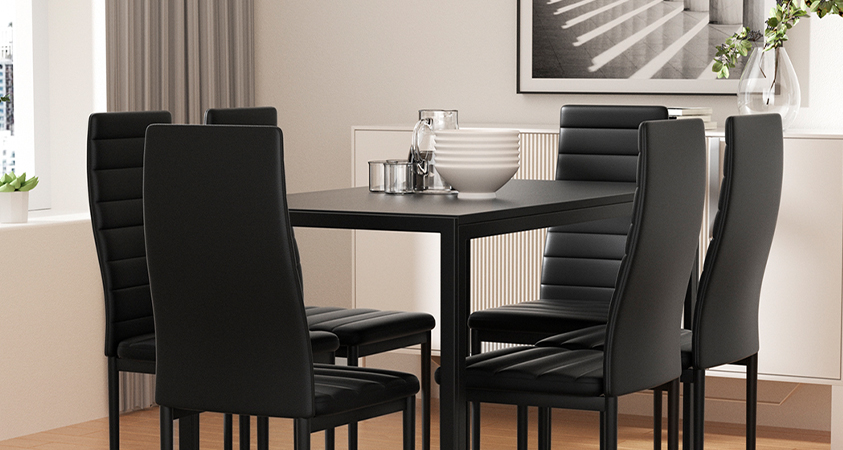
At Artiss, our expert curators are always on the hunt for the latest trending furniture pieces for your home. We’re always adding new products for you to enjoy, from elegant dining sets to no-fuss bed frames. You’ll enjoy the latest contemporary furniture pieces at affordable prices, and by following our blog you can keep up with the latest trends, tips and tricks from the interior design world.








